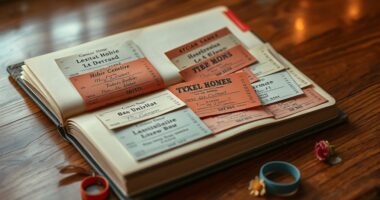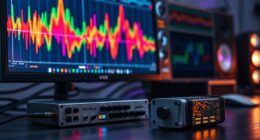If you’re looking to start your modular synth journey, I recommend checking out options like the Behringer Crave for hands-on control, the Donner ESSENTIAL L1 for beginner-friendly vintage sounds, and the Behringer complete Eurorack systems like System 55 or 15 for expanded sound design. DIY kits such as the Divison 6 Business Card Synth or Clouds Kit are great for building your skills. Keep reading to discover which kit suits your style and future growth plans.
Key Takeaways
- Consider beginner-friendly kits like Plaits or Donner ESSENTIAL L1 for ease of assembly and straightforward operation.
- Look for comprehensive starter bundles such as Cre8audio’s NiftyBUNDLE or Behringer System 55 with multiple modules and accessories.
- Prioritize compatibility with standard power supplies, CV, MIDI, and audio connections to ensure seamless integration.
- Evaluate your budget and choose kits that balance affordability with essential features for sound exploration.
- Focus on kits offering versatile modules for sound shaping, modulation, and expansion to support your musical growth.
Behringer Crave Analog Synthesizer with Sequencer

If you’re looking for an affordable yet powerful entry point into modular synthesis, the Behringer Crave Analog Synthesizer with Sequencer is an excellent choice. I find its semi-modular design and extensive patch matrix perfect for exploring sound creation. The 3340 VCO and classic ladder filter deliver rich, dark tones comparable to high-end synths like the Moog Mother 32, but at a fraction of the price. Its 32-step sequencer and external audio input open up endless possibilities. Despite a slight learning curve with manual operations, I appreciate its responsive controls and sturdy build. Overall, it’s an inspiring, versatile synth that’s great for beginners and seasoned musicians alike.
Best For: musicians and sound explorers seeking an affordable, versatile entry into analog and modular synthesis with hands-on control.
Pros:
- Rich, dark tones comparable to high-end synths like Moog Mother 32
- Extensive patch matrix and modulation options for creative sound design
- Robust build quality with silky smooth, responsive controls
Cons:
- Steep learning curve due to minimal documentation and manual operations
- Pattern saving requires power cycling, limiting real-time editing
- External software integration has limitations, such as delayed pattern updates
Donner ESSENTIAL L1 Synthesizer
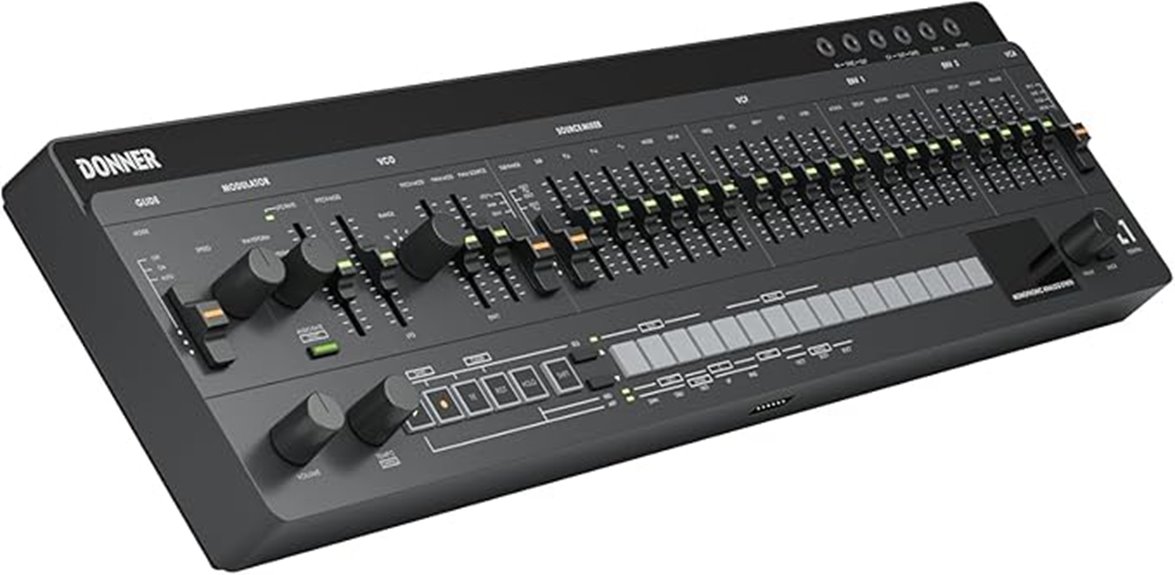
The Donner ESSENTIAL L1 Synthesizer stands out as an ideal choice for beginners and experienced musicians alike who want a versatile, portable, and easy-to-use analog synth. It delivers a vintage-inspired sound powered by a classic 3340 VCO chip and recreates iconic monophonic tones perfect for bass and leads. With multiple waveforms, sub-octave outputs, two velocity-sensitive ADSR envelopes, and a syncable LFO, it offers extensive sonic shaping. The built-in 64-step sequencer, arpeggiator, and various connectivity options make it a powerful, flexible tool. Its sleek, lightweight design and OLED display guarantee effortless operation, making it a perfect studio or live performance companion.
Best For: musicians of all levels seeking a portable, versatile, and easy-to-use analog synthesizer for studio or live performance.
Pros:
- Authentic vintage-inspired sound with modern enhancements and extensive waveform options.
- Compact, lightweight design with a sleek aesthetic and intuitive OLED display for effortless operation.
- Rich connectivity including CV/Gate, MIDI, USB-C, and modular compatibility, supporting diverse setups.
Cons:
- Monophonic focus may limit polyphonic playing for some users.
- Slightly limited in built-in effects or advanced sound sculpting features compared to higher-end synths.
- Price point, while budget-friendly, may still be a consideration for beginners on a tight budget.
Behringer System 55 Complete Eurorack Modular Synthesizer

For dedicated vintage synth enthusiasts looking to recreate classic sounds, the Behringer System 55 Complete Eurorack Modular Synthesizer offers an authentic, all-analog experience. It’s a faithful reproduction of a 1970s legendary modular, with 38 discrete modules including oscillators, filters, noise sources, and a step sequencer. The system is housed in two sturdy Eurorack cases with a reliable power supply, supporting complex patching. While assembly is straightforward, it’s best suited for experienced users familiar with modular synths. The sound quality is exceptional, capturing authentic vintage tones, though some quirks like mixed gate formats exist. Overall, it’s a thorough, vintage-inspired setup at a competitive price point.
Best For: vintage synth enthusiasts and experienced modular users seeking an authentic, all-analog reproduction of classic 1970s modular synthesizers.
Pros:
- Offers a comprehensive, authentic vintage sound with 38 discrete all-analog modules.
- Includes sturdy Eurorack cases with a reliable power supply supporting complex patching setups.
- High build quality with smooth knobs and detailed documentation, ideal for dedicated synth enthusiasts.
Cons:
- Assembly is straightforward but may be challenging for beginners; best suited for experienced users.
- Some quirks like mixed V-trig and S-trig gate formats may require workaround solutions.
- Additional cables and adapters are recommended, which can add $150–$200 to the total cost.
Behringer System 15 Complete Eurorack Modular Synthesizer
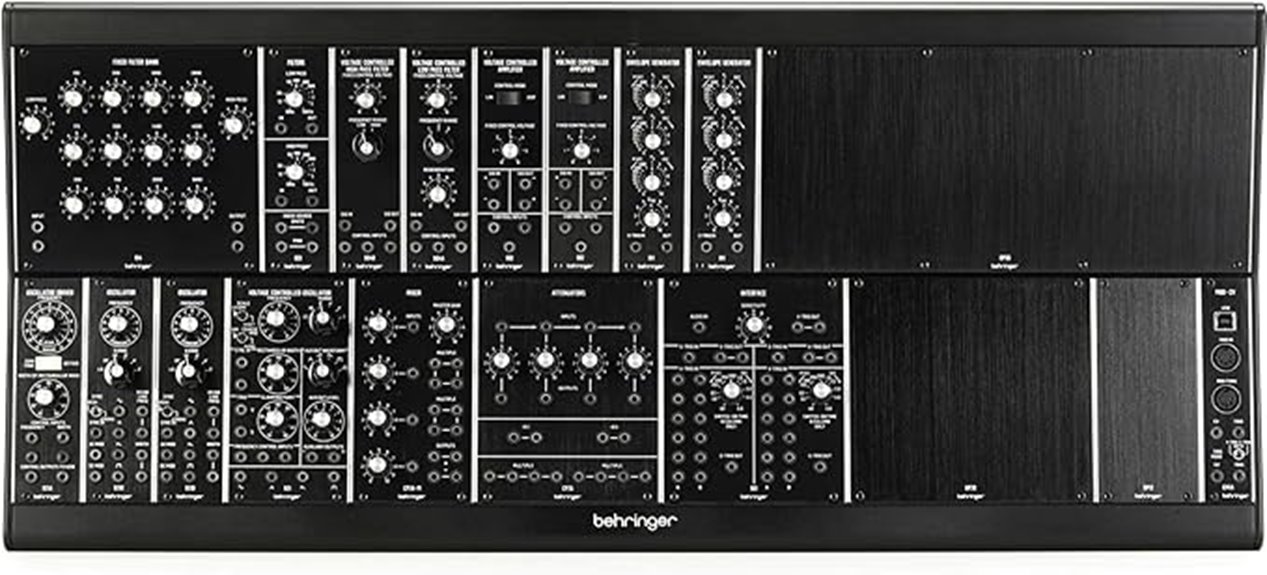
The Behringer System 15 Complete Eurorack Modular Synthesizer is an excellent choice for vintage synth enthusiasts who want an authentic retro sound combined with modern connectivity. It replicates a classic 1970s modular, offering 16 all-analog modules like oscillators, filters, and noise sources, all housed in a portable Behringer Eurorack Go Case. The system includes a 914 Fixed Filter Bank for detailed sound shaping and features MIDI-to-CV and USB connections, making integration with current gear effortless. Weighing around 17.7 pounds, it’s designed for both performance and transport, giving you a versatile, vintage-inspired platform to explore classic synth tones with contemporary convenience.
Best For: vintage synth enthusiasts seeking an authentic 1970s modular sound with modern connectivity and portability.
Pros:
- Offers 16 all-analog modules for authentic retro tones and versatile sound shaping
- Includes MIDI-to-CV and USB connectivity for seamless integration with modern gear
- Comes in a portable, durable Eurorack Go Case ideal for transport and live performance
Cons:
- Relatively heavy at 17.7 pounds, which may affect portability for some users
- Limited to the features and modules included; customization options are constrained by the system design
- May require some technical knowledge to fully utilize and integrate with other systems
Cre8audio Eurorack Synth Kit (NiftyBUNDLE)
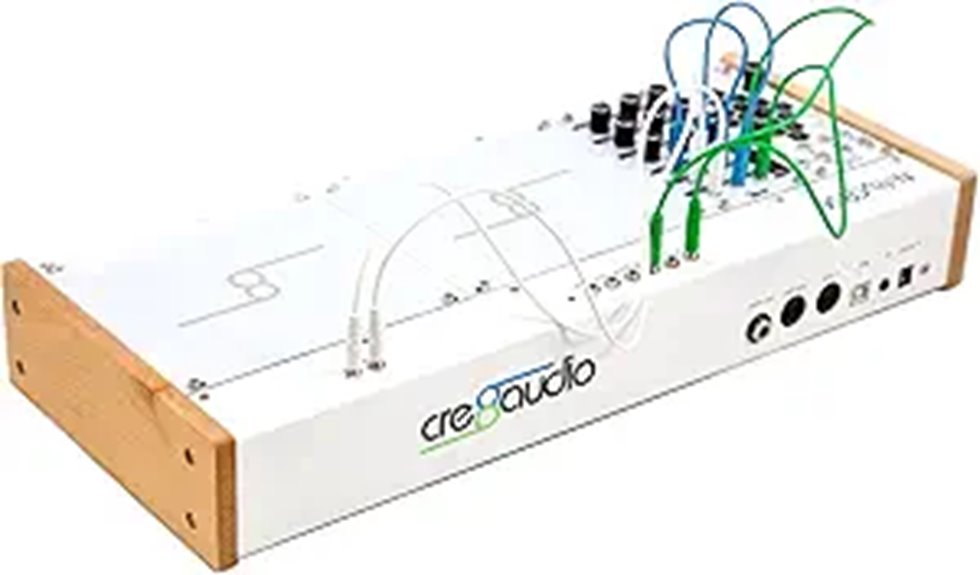
If you’re new to modular synthesis and want a complete, ready-to-play setup, the Cre8audio Eurorack Synth Kit (NiftyBUNDLE) is an excellent choice. It includes a sturdy 84HP case, a reliable power supply, two versatile modules—Chipz and Cello—patch cables, and blank panels, all designed for immediate use. Chipz offers gritty, chiptune-inspired sounds with dual VCOs and LFOs, while Cello provides expressive control through a programmable CV touch pad. The case features built-in MIDI to CV conversion, making integration with MIDI gear seamless. This bundle offers great value for beginners and those looking to expand their modular setup quickly and easily.
Best For: beginners and intermediate electronic musicians seeking a comprehensive, portable Eurorack starter kit with integrated MIDI control.
Pros:
- Complete package with case, modules, power supply, and accessories for immediate setup
- Versatile sound capabilities with gritty VCOs and expressive CV touch pad
- Seamless MIDI integration with built-in MIDI to CV conversion
Cons:
- Limited to two modules, which may restrict complexity for more advanced users
- Documentation could be more detailed for beginners unfamiliar with modular synthesis
- Slightly heavier and larger than ultra-compact setups, affecting portability for some users
Clouds Kit – Texture Synthesizer Eurorack Module by Sound Study Modular
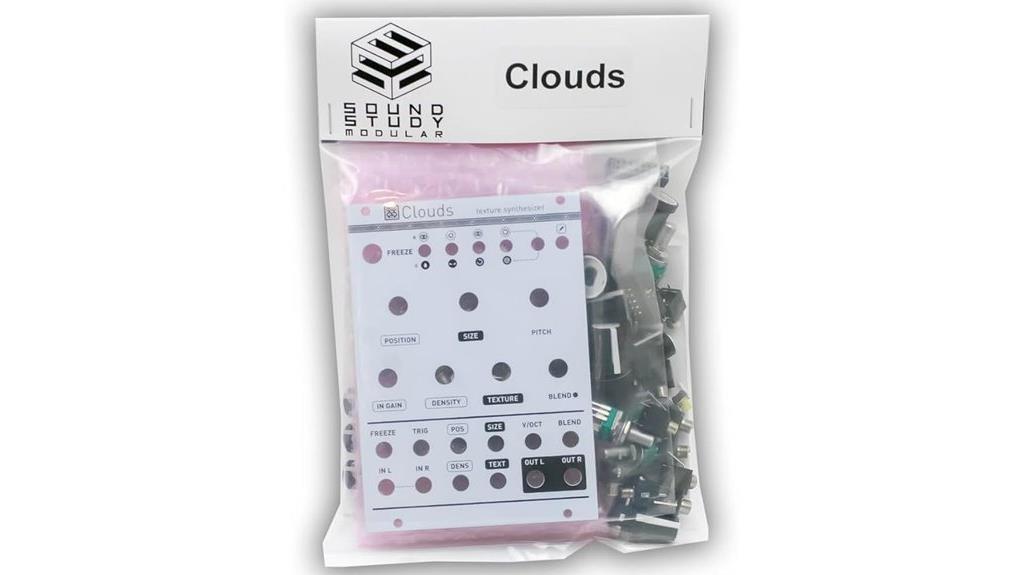
Clouds Kit by Sound Study Modular stands out as an ideal choice for experimental sound designers and ambient musicians enthusiastic to craft rich textures and evolving soundscapes. This finish-it-yourself Eurorack module is a powerful granular processor that manipulates sound segments to produce complex, layered textures. With adjustable delay, grain density, and shape controls, it offers deep sonic shaping options. Its “grain mesh” modes automatically generate pitch-shifted or time-stretched streams, perfect for dynamic textures. The kit includes a pre-soldered circuit, firmware, and an adaptable panel, making assembly straightforward. Clouds is versatile, inspiring, and perfect for those looking to add expressive, textured sounds to their modular setup.
Best For: experimental sound designers and ambient musicians seeking a versatile, DIY granular texture synthesizer module for rich, evolving soundscapes.
Pros:
- Easy to assemble with pre-soldered circuit and comprehensive instructions.
- Highly flexible sound shaping with adjustable grain size, density, pitch, and envelope shape.
- Includes innovative “grain mesh” modes for automatic, dynamic pitch-shifting and time-stretching effects.
Cons:
- Requires some soldering and basic electronics knowledge for assembly.
- May have a learning curve for users unfamiliar with granular synthesis techniques.
- Limited by the modular format, requiring compatible Eurorack setup for operation.
Turing Machine MkII Eurorack DIY Kit – Sound Study Modular Kit
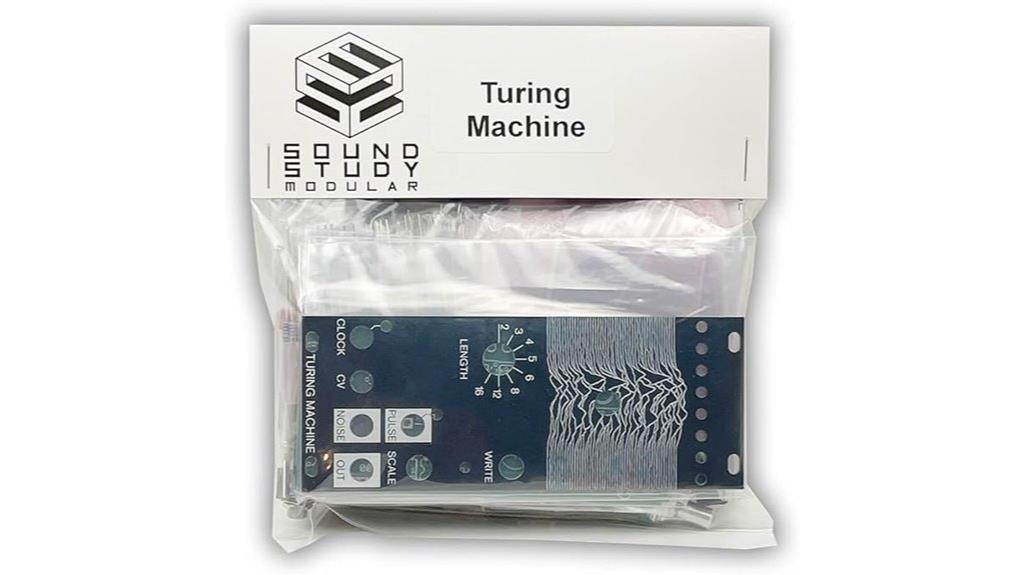
Designed for experimental sound designers and modular synth enthusiasts, the Turing Machine MkII Eurorack DIY Kit by Sound Study Modular stands out with its unique binary, random looping sequencer. It’s built around a 16-bit shift register memory circuit, producing unpredictable, clocked control voltages that create evolving soundscapes. Unlike traditional sequencers, you can’t program specific tunes or save sequences, but you can steer and lock loops of varying lengths for generative, generative-like patterns. Its compact 10HP size makes it perfect for Eurorack setups, offering an engaging hands-on experience for those wanting to explore chaos and randomness within their modular system.
Best For: experimental sound designers and modular synth enthusiasts seeking a compact, random, and generative control voltage sequencer for their Eurorack setup.
Pros:
- Compact 10HP design ideal for space-conscious Eurorack systems.
- Creates evolving, unpredictable soundscapes perfect for experimental music.
- Simple to assemble with accessible instructions, making it suitable for DIY enthusiasts.
Cons:
- Cannot be programmed to play specific, repeatable sequences or save patterns.
- Limited control over sequences, which may not suit users seeking precise melody programming.
- Requires DIY assembly, which may be challenging for beginners without prior kit experience.
Division 6 Business Card Synthesizer DIY Kit
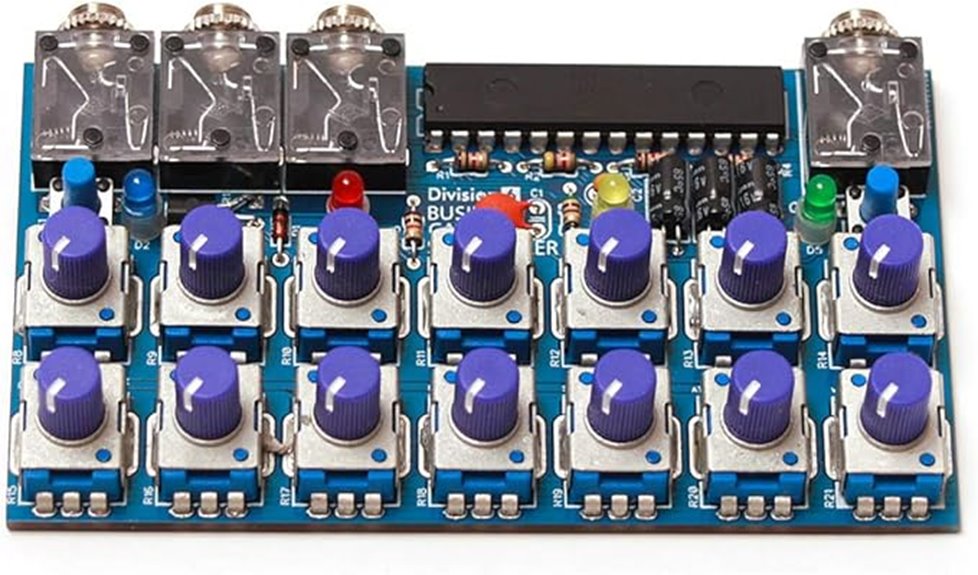
The Division 6 Business Card Synthesizer DIY Kit is perfect for enthusiasts who want a compact, hands-on introduction to synth sound creation. This kit allows you to build a versatile, portable synth that can connect to other gear or run solo. It features multiple waveforms, two LFOs, and sound-shaping controls like filters and Glide, giving you plenty of modulation options. The build involves soldering small components, making it a great learning experience for those comfortable with basic electronics. Once assembled, you can generate rich sounds with manual triggers and tweak the parameters for unique tones, all while enjoying its small, lightweight design.
Best For: hobbyists and electronic music enthusiasts seeking a hands-on, portable synth building experience with versatile sound design capabilities.
Pros:
- Compact and lightweight, ideal for portable use and educational purposes
- Offers multiple waveforms and modulation options for creative sound design
- Includes a headphone output for easy, standalone sound generation
Cons:
- Assembly requires medium soldering skills and careful component handling
- Limited troubleshooting guidance may challenge beginners during build
- Support from manufacturer can be limited if issues arise post-assembly
Passive Mult DIY Kit
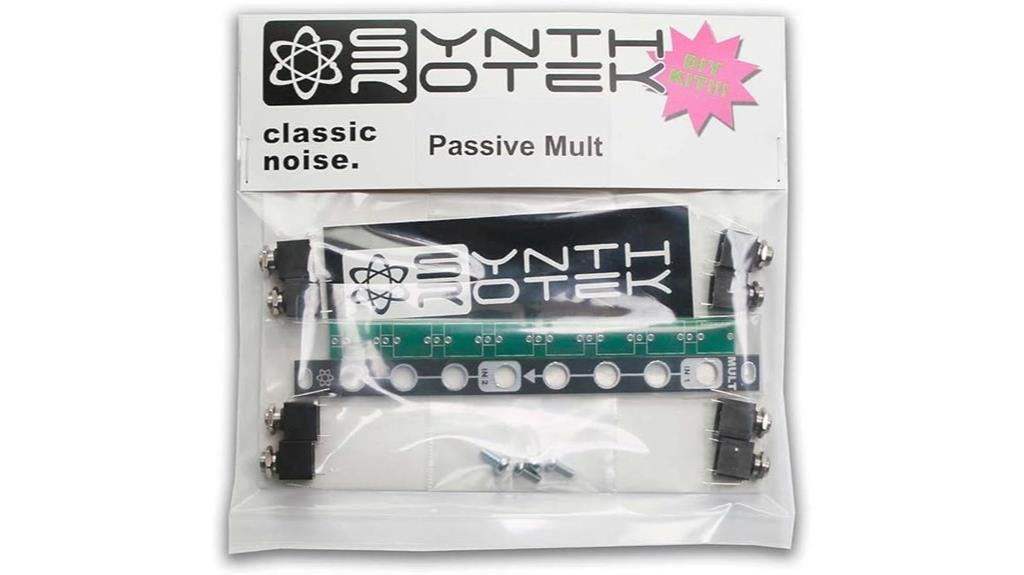
If you’re just starting out with modular synthesis and want a simple, cost-effective way to multiply control voltages or audio signals, the Passive Mult DIY Kit by Synthrotek is an excellent choice. This compact 2HP Eurorack module offers either a 2x 1-to-3 passive multiplier or a single 1-to-6 setup, making signal distribution easy without requiring buffers. Its straightforward design makes it perfect for beginners, and assembly is simple thanks to its small parts count. With no power draw and compatibility with standard 3.5mm jacks, it’s a versatile tool for expanding your system’s capabilities without complexity or expense.
Best For: beginners and DIY enthusiasts looking for an affordable, straightforward solution to multiply control voltages or audio signals in Eurorack modular synthesizer systems.
Pros:
- Compact 2HP width ideal for small Eurorack setups
- Simple, no-power passive design suitable for beginners
- Versatile 2x 1-to-3 or 1-to-6 voltage multiplication options
Cons:
- No buffered or voltage-accurate multiplication, which may affect precision
- Requires assembly, which might be challenging for complete beginners
- Limited to passive signal multiplication without additional buffering or buffering options
Plaits Kit – Eurorack Oscillator Module Kit by Sound Study Modular

For those new to modular synthesis, the Plaits Kit by Sound Study Modular offers an excellent entry point thanks to its straightforward assembly process and versatile sound engine. This kit includes pre-soldered parts, a panel, and firmware, making setup accessible even for beginners. It features eight synthesis models, from virtual analog and FM to speech and percussion sounds, providing a broad sonic palette. The tactile controls and internal envelopes offer intuitive modulation without screens. Compact at 12HP and lightweight, it’s perfect for expanding your system. Assembly is simple with instructions on the website, enabling quick immersion into sound design and synthesis.
Best For: beginners and intermediate synthesists seeking an accessible, versatile, and easy-to-assemble Eurorack oscillator module that offers a broad range of sounds and tactile control.
Pros:
- Simplified assembly process with pre-soldered components and clear instructions, ideal for newcomers.
- Wide sonic palette including virtual analog, FM, speech, and percussion sounds for creative flexibility.
- Compact and lightweight design (12HP) with tactile controls and internal envelopes for intuitive modulation.
Cons:
- Requires manual assembly, which may be challenging for those without soldering experience.
- Limited to Eurorack format, necessitating a compatible modular system.
- No built-in screen, so users rely solely on tactile controls and internal modulation for sound shaping.
Korg Nu:Tekt NTS-1 MKII Build Your Own Digital Synthesizer Kit
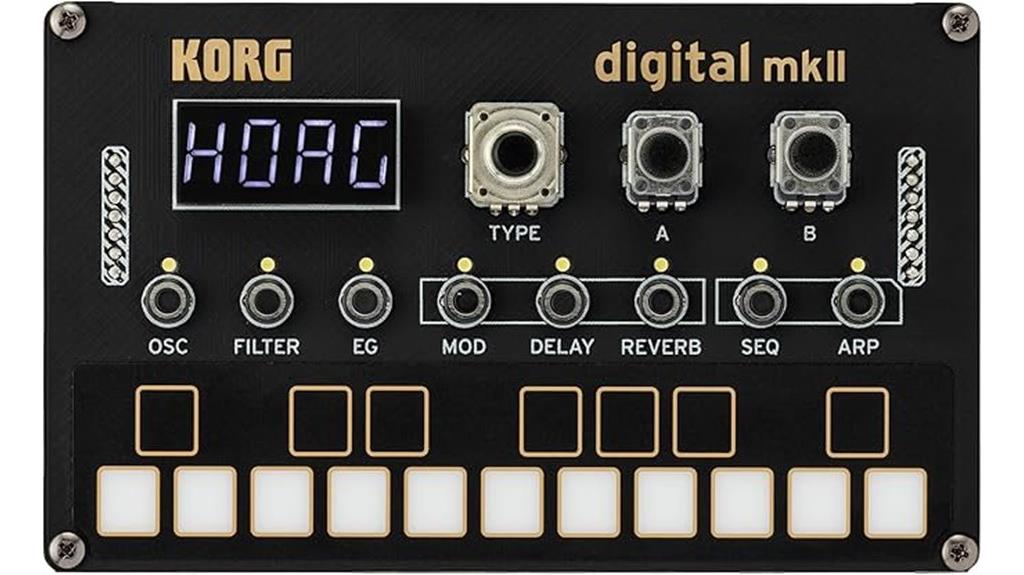
Designed for electronic music enthusiasts who enjoy hands-on customization, the Korg Nu:Tekt NTS-1 MKII Build Your Own Digital Synthesizer Kit offers an accessible way to craft a personalized synthesizer. Its compact, portable design makes it perfect for creating music anywhere, whether in the studio or live. The 18-key multitouch keyboard allows precise play, complemented by an integrated arpeggiator and 8-step sequencer for expressive performances. With advanced sound-shaping features like a multimode filter, envelope generator, and three LFOs, this kit releases versatile sound design. It’s an ideal starting point for anyone enthusiastic to explore synthesis through a fun, hands-on build.
Best For: electronic music enthusiasts and DIY synth builders seeking a customizable, portable digital synthesizer kit for creative sound design and performances.
Pros:
- Compact and portable design ideal for on-the-go music creation and live performances
- Fully customizable with advanced sound-shaping features like multimode filter, envelope generator, and three LFOs
- Includes an 18-key multitouch keyboard, arpeggiator, and 8-step sequencer for expressive playing
Cons:
- Requires assembly, which may be challenging for users without technical experience
- Limited to digital synthesis, possibly needing additional hardware for hybrid setups
- May have a learning curve for beginners unfamiliar with synthesis concepts
4093 Chaos NAND Handheld DIY Kit – LoFi Drone Oscillator Synth
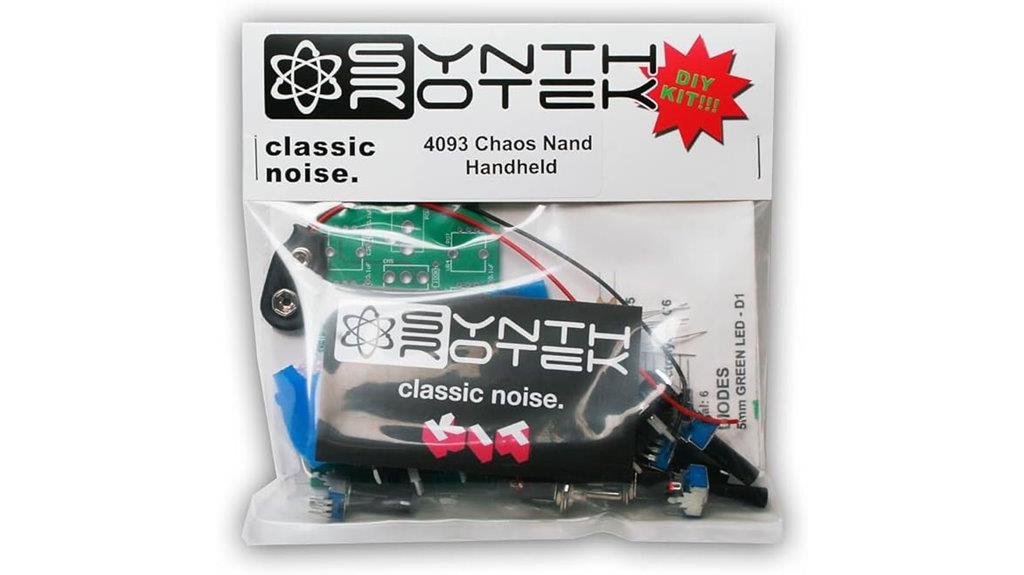
The 4093 Chaos NAND Handheld DIY Kit stands out as an ideal choice for enthusiasts keen to explore LoFi drone synthesis and chaos effects. This easy-to-build kit features three NAND oscillators, each offering unique sound textures, plus two gating oscillators with on/off switches for dynamic control. It’s powered via CV SAG input, making it compatible with sequencers, envelopes, and LFOs, and includes a power switch for convenience. The dive bomb/laser effect button adds real-time modulation, perfect for experimental sound design. Its compact design makes it perfect for hands-on learning and creative exploration of chaos and drone sounds.
Best For: enthusiasts and experimental sound designers interested in DIY LoFi drone synthesis and chaos effects seeking a versatile, compact handheld synth kit.
Pros:
- Easy-to-build kit suitable for beginners and hobbyists.
- Versatile sound shaping with three NAND oscillators and gating controls.
- Compatibility with CV gear like sequencers, envelopes, and LFOs for dynamic modulation.
Cons:
- Limited to LoFi drone and chaos sounds, which may not suit all musical styles.
- Requires some technical skill for assembly and understanding of CV controls.
- Small form factor may limit extensive modulation options or expandability.
Erica Synths Output Kit

If you’re looking to connect your modular synthesizer with external gear seamlessly, the Erica Synths Output Kit is an excellent choice. It’s a dedicated output module that makes interfacing easy, with L and R inputs for stereo connections. Plus, it features a headphones volume control, so you can monitor your sound directly. The kit includes all necessary components—ICs, knobs, a power cable, and other essentials—making setup straightforward. Its skiff-friendly design ensures it fits neatly into compact setups. Overall, this kit simplifies external connections, enhances your monitoring capabilities, and integrates smoothly into your modular system.
Best For: musicians and producers seeking a reliable, easy-to-integrate output module for their modular synthesizer setup that supports stereo connections and monitoring.
Pros:
- Facilitates seamless stereo interfacing with external gear.
- Equipped with a headphones volume control for easy monitoring.
- Skiff-friendly design allows for compact and flexible setup integration.
Cons:
- May require basic knowledge of modular synth connections for setup.
- Limited to output functions, not suitable for processing or modulation.
- Does not include power supply, so additional setup may be needed.
AstroNoise LoFi DIY Synth Kit

The AstroNoise LoFi DIY Synth Kit is perfect for hobbyists and artists looking to craft unique, vintage-inspired soundscapes. This massive, video game-inspired noise-making machine lets you shape galactic frequencies with four onboard controls: Oscillator Rate, two LFOs, and LFO pitch. The Tone Select Switch offers three classic sound options, allowing you to dial in nostalgic tones or experimental textures. It’s powered by a 9V center-negative supply or battery (not included). Whether you want rhythmic modulation or cosmic noise, this kit provides a fun, hands-on way to explore vintage-inspired synthesis and create otherworldly sounds.
Best For: hobbyists, vintage sound enthusiasts, and experimental musicians seeking a hands-on, galactic-inspired noise synthesis experience.
Pros:
- Offers customizable vintage video game-inspired sounds with multiple modulation options
- Easy to use with four onboard controls for intuitive sound shaping
- Portable power options include 9V battery or center-negative power supply
Cons:
- Requires a 9V power supply or battery (not included), which may be an extra purchase
- May have a learning curve for beginners unfamiliar with DIY synth kits
- Limited to three preset tone options, which might restrict some sound variety
Synth-a-Sette Portable Cassette Synthesizer

Looking for a portable synthesizer that combines fun, simplicity, and creative potential? The Synth-a-Sette Portable Cassette Synthesizer is perfect for that. It’s tiny, pocket-sized, and includes a built-in speaker, line out, and a 13-key monophonic touchpad, making it easy to play melodies anywhere. It features an octave up button and an optional vibrato switch, offering versatile sound creation for beginners and pros alike. You can even invent your own keyboard by connecting conductive objects like fruits or forks, encouraging musical experimentation. Designed by MicroKits, it’s a great tool for both STEM learning and musical exploration on the go.
Best For: musicians, students, and hobbyists seeking a portable, easy-to-use synthesizer for musical experimentation and STEM learning.
Pros:
- Compact, pocket-sized design with built-in speaker and line out for versatile use
- Creative customization options like connecting conductive objects to invent your own keyboard
- Suitable for beginners and experienced users with features like octave up and vibrato switch
Cons:
- Limited to monophonic sound with a 13-key touchpad, which may restrict complex melodies
- May require additional equipment or creativity for more advanced sound design
- Small size might make it less suitable for extended performance or detailed editing
Factors to Consider When Choosing Modular Synth Starter Kits

When choosing a modular synth starter kit, I consider my budget and how much I’m willing to spend upfront. I also look at how well the modules connect and whether they’re compatible with my existing gear. Finally, I focus on sound quality, ease of assembly, and selecting modules that match my musical goals.
Budget and Cost
Choosing a modular synth starter kit requires careful attention to your budget, as prices can range from around $50 for basic options to over $500 for more advanced sets. It’s important to contemplate the cost of additional accessories like patch cables, power supplies, or cases, which can add considerably to the overall expense. Comparing the features included in a kit helps ensure you’re getting good value for your money—more modules often mean more versatility, but they aren’t always necessary for beginners. Keep in mind that higher-priced kits typically offer expandability, but if you’re just starting out, a simpler, more affordable set may be enough. Also, think about potential future costs if you plan to grow your system over time.
Compatibility and Connectivity
Ensuring compatibility and connectivity is crucial when selecting a modular synth starter kit, as it determines how easily your new system will integrate with your existing gear. Make sure the kit includes compatible power supplies and connectors that match your current setup or planned configuration. Check for essential input/output options like CV, gate, MIDI, USB, or audio jacks to connect seamlessly with other instruments or controllers. It’s also important to verify standardized control voltages such as 1V/Oct, V-trig, or S-trig, ensuring smooth integration across different modules and synthesizers. Additionally, consider whether the kit supports external devices like MIDI controllers, computers, or instruments. Finally, confirm that cables, adapters, or interfaces match your workflow, making connections straightforward and hassle-free.
Module Selection
Selecting the right modules for your starter kit means balancing sound sources, modulation, and utility functions to build a versatile system. I recommend including a variety of oscillator types to explore different synthesis techniques and create richer sounds. Utility modules like mixers, attenuators, and multiples are essential for signal routing and modulation, making your setup more flexible. Choose modules with clear, tactile controls and labels—this makes learning and experimenting more intuitive. It’s also important to balance the number of sound-generating modules with control and modulation options to allow for growth. Ultimately, check compatibility and form factors, like Eurorack standards, to ensure your modules fit together seamlessly and can be expanded easily over time.
Sound Quality
The sound quality of a modular synth starter kit hinges on the quality of its core components, especially oscillators, filters, and circuitry. Pure analog circuits tend to produce warmer, richer tones compared to digital or hybrid modules, shaping the overall character of your sound. High-resolution control voltage inputs and stable power supplies are essential for maintaining consistent, clear audio without unwanted noise or distortion. Classic synthesis circuits, like ladder filters or voltage-controlled oscillators, add authenticity and versatility to your sound palette. Modules designed with low distortion, wide frequency response, and minimal signal degradation ensure professional-quality results. When choosing a kit, prioritize these factors to guarantee your setup can produce high-fidelity, dynamic sounds that truly inspire your creative journey.
Ease of Assembly
When choosing a modular synth starter kit, ease of assembly can make a significant difference in your overall experience. I recommend looking for kits that include detailed instructions or tutorials, especially if you’re new to the process. Kits with pre-soldered or surface-mount components help reduce complexity and save time. Pay attention to the size and number of parts; smaller components can be tricky to handle and solder. Modular or plug-and-play modules that snap together make building much simpler and faster. Additionally, customer reviews often reveal real-world insights into assembly challenges, helping you gauge whether a kit is beginner-friendly. Prioritizing these factors can turn the assembly process from a formidable task into an enjoyable part of your sound journey.
Expansion Potential
Considering expansion potential is essential because it determines how well your modular synth can grow with your evolving needs. I recommend choosing a starter kit that either includes a wide range of modules or is compatible with various third-party options, especially those following the standard Eurorack format. This flexibility allows for seamless integration of new modules as your skills and interests develop. Additionally, check the power supply capacity to ensure it can support future modules without issues. Look for systems with open architecture or expansion ports that make adding new components simple. Finally, consider the manufacturer’s selection of expansion modules—having a variety readily available makes ongoing growth smoother and more exciting, ensuring your system can adapt and expand over time.
Build Quality
Build quality plays a crucial role in making certain your modular synth remains reliable and enjoyable to use over time. Durable materials like metal enclosures and sturdy connectors help it withstand regular use and transportation, reducing damage risks. Precision manufacturing, with tight tolerances for knobs, switches, and jacks, ensures consistent performance and easier patching. Well-constructed kits feature clean soldering, robust circuit boards, and secure component mounting, which contribute to stable operation. Investing in a kit with solid build quality minimizes maintenance needs and provides a more satisfying tactile experience during sound design. When choosing a starter kit, prioritize these factors to ensure longevity, reliability, and a seamless playing experience that supports your creative journey.
Versatility and Features
Choosing a modular synth starter kit with versatile features expands your creative options and allows for more dynamic sound design. A good kit should include a variety of modules like oscillators, filters, and envelopes, giving you a broad palette to work with. Features such as patch bays, multiple modulation sources, and extensive connectivity options boost adaptability for different styles and experimental setups. Support for external control signals like MIDI or CV opens up integration with other gear, enhancing your workflow. Built-in sequencing and arpeggiator functions let you perform complex sequences without extra equipment. Additionally, ensuring compatibility with various Eurorack standards and future expansion modules guarantees long-term growth and flexibility, allowing your system to evolve as your skills and needs develop.
Frequently Asked Questions
What Safety Precautions Are Necessary When Building DIY Synth Kits?
When building DIY synth kits, I always make sure to unplug everything before wiring or soldering. I wear safety goggles to protect my eyes from solder splashes and work in a well-ventilated area to avoid inhaling fumes. I double-check connections and follow instructions carefully to prevent short circuits. Handling components gently also prevents damage, and I keep a fire extinguisher nearby just in case.
How Do I Upgrade My Starter Kit for Advanced Sound Design?
Think of your starter kit as a garden plot—upgrading is like adding new plants and tools for richer growth. I suggest exploring complex modules like multi-oscillators and filter banks, and experimenting with patching techniques to unlock advanced sounds. Incorporate effects and sequencing modules to expand your creative palette. By gradually introducing these elements, you’ll cultivate a more sophisticated and expressive setup, turning your simple patch into a lush, dynamic sonic landscape.
Are There Compatible Accessories for Different Modular Synthesizer Brands?
Yes, there are compatible accessories for different modular synthesizer brands. I always check the specifications and voltage standards before purchasing, as most Eurorack modules are compatible across brands, but some, like Moog or Make Noise, might have unique connectors or power requirements. I recommend using universal power supplies and patch cables to guarantee compatibility and avoid damage. Always double-check the compatibility info to keep your setup flexible and expand effortlessly.
What Is the Typical Lifespan of DIY Modular Synthesizer Components?
The typical lifespan of DIY modular synthesizer components varies, but with proper care, they can last many years—often a decade or more. I’ve found that using quality parts, avoiding static, and storing components in a dry, stable environment helps extend their longevity. Regular maintenance and occasional troubleshooting also keep everything running smoothly. Honestly, with a little attention, your DIY synths can serve you well for a very long time.
Can I Integrate My Starter Kit With Digital Audio Workstations (DAWS)?
Yes, you can definitely integrate your starter kit with digital audio workstations (DAWs). I’ve done it myself by connecting my modular synth via audio interfaces, which allows me to record and manipulate sounds directly in my DAW. Most modular synths have CV or MIDI outputs that work seamlessly with DAWs, making it easy to expand your setup and incorporate your analog sounds into your digital workflow.
Conclusion
Jumpstarting your modular synth journey feels like opening a treasure chest of sonic possibilities. With these top kits, you’ll be crafting unique sounds in no time—like a painter with a brand-new palette. Remember, the right starter kit is your trusty steed on this musical adventure. So, pick one that sparks your curiosity, explore, and let your creativity flow wild. Your future soundscape is just waiting to be accessed!





